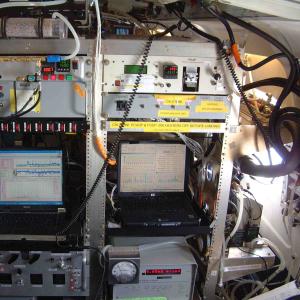1) Time of Flight Aerosol Mass Spectrometer (ToF-AMS)
Total and single particle characterization of volatile aerosol ionic and organic components (50-700nm). Uncertainty depends on species and concentration.
2) Single Particle Soot Photometer (SP2)
Single particle measure of BC (soot) mass in particles and determination of mixed particle size and non-BC coating using laser scattering and incandescence. 70-700nm. Single particle counting up to 10,000 per sec.
3) A size-resolved thermo-optic aerosol discriminator (30 s avg.):
Aerosol size distribution from 0.12 up to 7.0 μm, often where most aerosol mass, surface area and optical effects are dominant. Uses a modified Laser Optical Particle Counter (OPC) and computer controlled thermal conditioning system is used upstream (airstream dilution dried). Characterizes aerosol components volatile at 150, 300 and 400C and refractory aerosol at 400C (sea salt, dust and soot/flyash). (Clarke, 1991, Clarke et al., 2004). Uncertianty about 15%
4) Condensation Nuclei - heated and unheated (available at 1Hz)
Two butanol based condensation nuclei (CN) counter (TSI 3010) count all particles between 0.01-3.0 um. Total CN, refractory CN (those remaining at 300C after sulfate is removed) and volatile CN (by difference) are obtained as a continuous readout as a fundamental air mass indicator (Clarke et al. 1996). Uncertainty ~ 5%.
5) Aerodynamic Particle Sizer – (APS-TSI3320) – (<5min/scan)
To further characterize larger “dry” particles, including dust, an APS is operated which sizes particles aerodynamically from 0.8 to 20 μm into 50 channels. Uncertainty~10%.
6) Differential Mobility Analyzer with thermal conditioning – (<3 min/scan)
Volatility tandem thermal differential mobility analyzer (VTTDMA) with thermal analysis that provides size information (mass, surface area, number distributions) and their state of mixing over the 0.01 to 0.3μm size range (Clarke et al., 1998, 2007) for sampling times of about 1-3 minutes. Uncertainty ~10%
7) Nephelometer (10-7 m-1 detection for 60s avg., recorded every 1 sec.)
A 3 wavelength nephelometer (450, 550, 700nm) is used for total scattering and submicrometer scattering values using a Radiance Research single wavelength nephelometer (and thereby coarse dust scattering by difference).
8) Two Particle Soot Absorption Photometers (PSAP-Radiance Research; detection <0.1μg m-3 for 5 min. avg. )
The PSAP is used to quantify the spectral light absorption coefficient of the total and submicron aerosol (eg. soot, BC) at three wavelengths (450, 550, 660nm).
9) Humidity Dependent Light-Scattering (10-6 m-1 detection for 60s avg.; recorded every 1 s)
Two additional Radiance Research single-wavelength nephelometers are operated at two humidities (high/low) to establish the humidity dependence of light scattering, f(RH).


